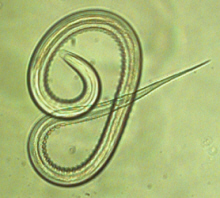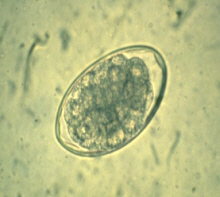



Keeping the Threat of Drug Resistant Cattle Nematodes at Bay
Anthelmintic management has so far kept the threat of cattle nematodes under control, but without advanced methods of prevention, growing resistance could open the box to a new set of problems, writes Adam Anson, TheCattleSite.
Images courtesy of Dr Peter Geldhof, Faculty of Veterinary Medicine, University of Ghent, Belgium
Nematodes are tiny parasites, but they have the potential to cause big repercussions for those within the livestock industry. Their life-cycle involves the adult worms breeding inside cattle stomach/intestines, with eggs passed out in dung/faeces, where they hatch and develop into infective larvae. These larvae remain on pasture lying in wait until they are ingested by cattle. Following ingestion the larvae develop and mature in the cattle gut to complete the cycle. The adult worms feed within their host’s digestive tract and when present in large numbers cause a range of symptoms from diarrhea, reduced growth and, occasionally, death.
Scientists at the Moredun Research Institute outside Edinburgh have a long history in research on parasite control and were recently key participants in the PARASOL project, a European Framework 6-funded project under the Food Quality and Safety theme. Members of the project have labelled these gastro-intestinal nematodes as "one of the greatest threats to animal production worldwide", due to the fact that they lead to poor food quality, poor animal welfare and low profitability. They believe that the control of parasitic infections is paramount.
An Arms Race

Images courtesy of Dr Peter Geldhof, Faculty of Veterinary Medicine, University of Ghent, Belgium
Current methods for controlling nematodes in livestock revolve around repeated doses with synthetic drugs (anthelmintics). Historically, this has proved successful, but scientists warn that intensive drug treatment strategies are not sustainable. Chemical residues have the potential to build up in meat and milk and also in the environment, causing long lasting food safety concerns. However, a more immediate problem, given the limited supply of drugs currently available, is the emergence and spread of anthelmintic resistance (AR) within the parasite population.
Resistance is the ability of worms to survive the normal effective dose of an anthelmintic and pass this genetic ability to their offspring. Once the majority of worms become resistant to all available treatments, options for control become severely limited. Effectively, nematodes acquire free reign until scientific advances can bring a new weapon to the pasture. For this reason, the situation is often referred to as an arms race. There are currently only three chemical classes of anthelmintics available and resistance is now well established to all three of these in sheep, especially in New Zealand, Australia and South Africa, but also in the UK.
Past mistakes led the sheep industry far down a path that it didn't want to take. Rather than preventing the progression of these drug resistant nematodes, some of the adopted strategies actually promoted it by inadvertently selecting for resistant worms. This was exemplified by the “dose and move” strategy in which infected animals are treated with an anthelmintic and then moved onto clean grazing, Whilst it was believed that this would dilute the population of nematodes to an ineffectual level on pasture, it actually resulted in the pasture becoming rapidly contaminated with eggs from resistant parasites, which survived treatment at the expense of their susceptible counterparts.
A difficult dilemma soon began to emerge, pitting short term economic pressure against long term sustainability. Whilst it is difficult to accurately assess the economic toll of nematodes, it has been estimated at an annual rate of £65 million for the UK sheep industry alone. Here, according to reports by veterinary investigation services, cases of gastro-intestinal nematodes continue to increase. For many afflicted sheep producers the situation has become impossible and they have been left with no alternative but to leave the industry for good.
It should be taken into account that one of the reasons that resistance has been less commonly reported in cattle is that they develop stronger immunity to worms than sheep, and therefore, need less treatment. However, resistance in cattle parasites has been detected in the Southern Hemisphere and is now acknowledged to be an emerging problem across Europe.
The fallibility of current anthelmintics in the sheep industry has left many ruminant farmers wondering what options will be available to them when resistant nematodes arrive on their pastures. But, whilst the problems posed by AR within the sheep industry serve as a stark warning to the cattle industry, they also bring new insight into its management. One lesson researchers have learnt is not to wait for that day to arrive, but instead to pursue carefully considered preemptive interventions today. Consequently the life of current wormers can be extended well into the future.
The New, Intelligent Front
Producers are being advised to turn to vets and advisers in order to gain advice on how to limit the use of wormers to that which is necessary, preserving the population of susceptible worms on their farms. Producers should manage worms by using ‘non-chemical’ as well as ‘chemical’ control options, if at all possible. Further steps involve careful monitoring to determine the resistance status of the worms and the effectiveness of the anthelmintics being used, as well as sound rotation of worming groups and quarantine doses to avoid buying in resistant worms. Since underdosing also selects for resistance it is also important that producers use the correct dose, whilst ensuring optimum drenching techniques.
Researchers at Moredun are currently investigating methods of enhancing the efficacy of available drugs against a background of multiple resistance and, through pharmacokinetic studies, novel means of enhancing bioavailability of the drugs within the host. They are also investigating a number of alternative prophylactic approaches to the control of nematodes that utilise either host immunity or plants with natural anthelmintic properties to regulate parasite populations within the host.
One highly promising area of research at Moredun is the potential development of a worm vaccine. According to the institute, "hidden antigen studies at Moredun have identified and patented a number of promising candidate antigens from Haemonchus contortus, a haematophagous parasite that has a huge impact on sheep production throughout the world. Several studies using one microvillar extract H-gal-GP have provided more than 90 per cent reduction in egg count and 70 per cent reduction in worm burden." This hidden antigen approach to vaccination is also being pursued with the major cattle parasite, Ostertagia ostertagi.
The PARASOL Project is looking at low input, sustainable programmes for nematode control by developing strategies for Targeted Selective Treatment (TST). TST focuses on minimising the numbers of whole herd anthelmintic treatments by directing individual treatments towards only those animals that require treatment. The basic idea is simple - animals that are adversely affected by nematode parasites show a range of clinical signs, including anaemia, diarrhoea or reduced productivity, whereas animals with low worm burdens, or those that are resilient regarding infection, do not. Using liveweight gain for sheep and a parasite-specific milk ELISA test in cattle as treatment indicators, results from PARASOL field trials show that it is possible to significantly reduce the number of anthelmintic treatments but still preserve anthelmintic efficacy with no loss in productivity.
By the end of the project, PARASOL hope to provide recommendations on how to preserve anthelmintic efficacy and clear guidance and protocols for sustainable, low-input, user- and consumer friendly farm plans on nematode control. PARASOL scientists are also working towards a computerised decision support system for identifying those animals that require treatment. It is hoped that these strategies will then be relayed to farmers, veterinarians, advisors and trained animal health technicians throughout participating countries. Ultimately, the idea is to incorporate them into larger “farm-to-fork” production schemes.
The emergence of multiple anthelmintic resistance has also provided a spur for research on alternative forms of control, prompting the search for new anthelmintics by the major veterinary pharmaceutical companies. This has resulted in the discovery of the first new anthelmintic class for 25 years, the amino acetonitrile derivatives or AADs (monepantel). This compound, marketed as Zolvix® (Novartis Animal Health) has recently been launched onto the market in New Zealand for worm control in sheep. Zolvix® will probably be launched in the UK/Europe in the not too distant future.
However, even with a new class of wormer in hand, anthelmintic resistance is not likely to go away. It is imperative, therefore, that we preserve the active life of the currently available anthelmintics but also learn the lessons of the past and make best use of any new products which may reach the market. In this way, we will maintain a basket of options for sustainable parasite control in the future.
The author would like to acknowledge Dr Philip Skuce, Moredun Research Institute, for his help in writing this article.
June 2009


